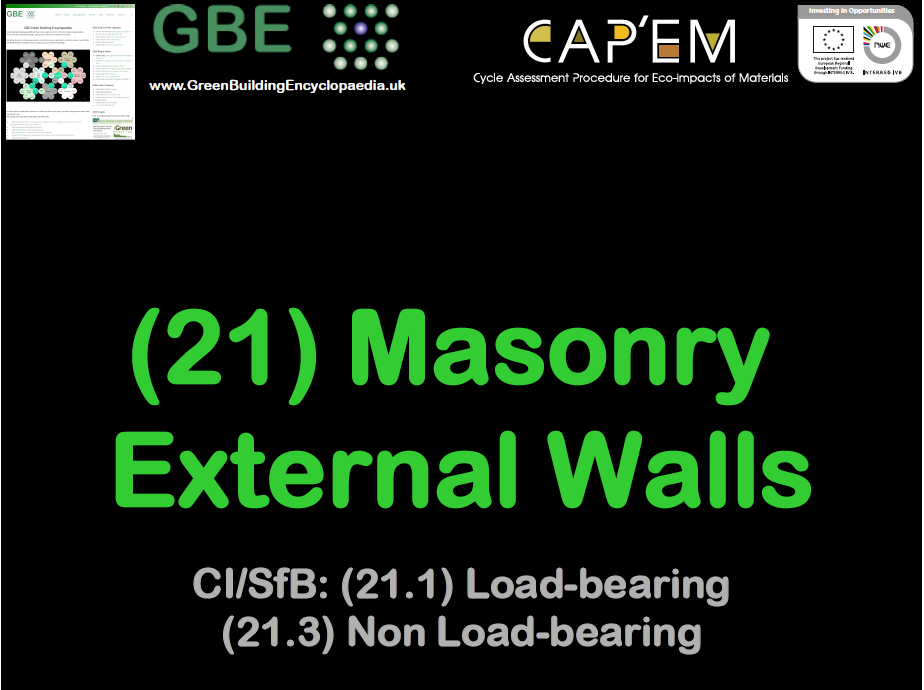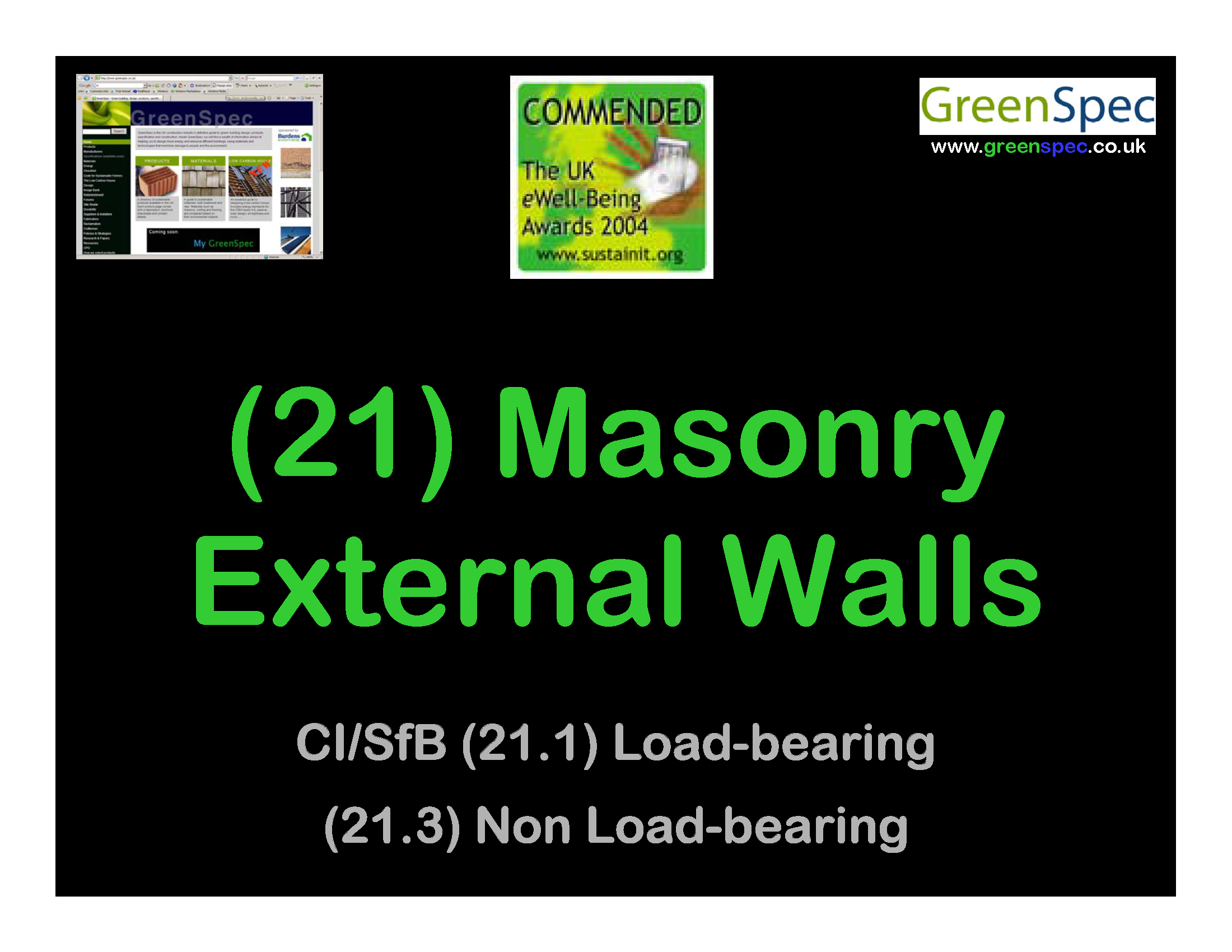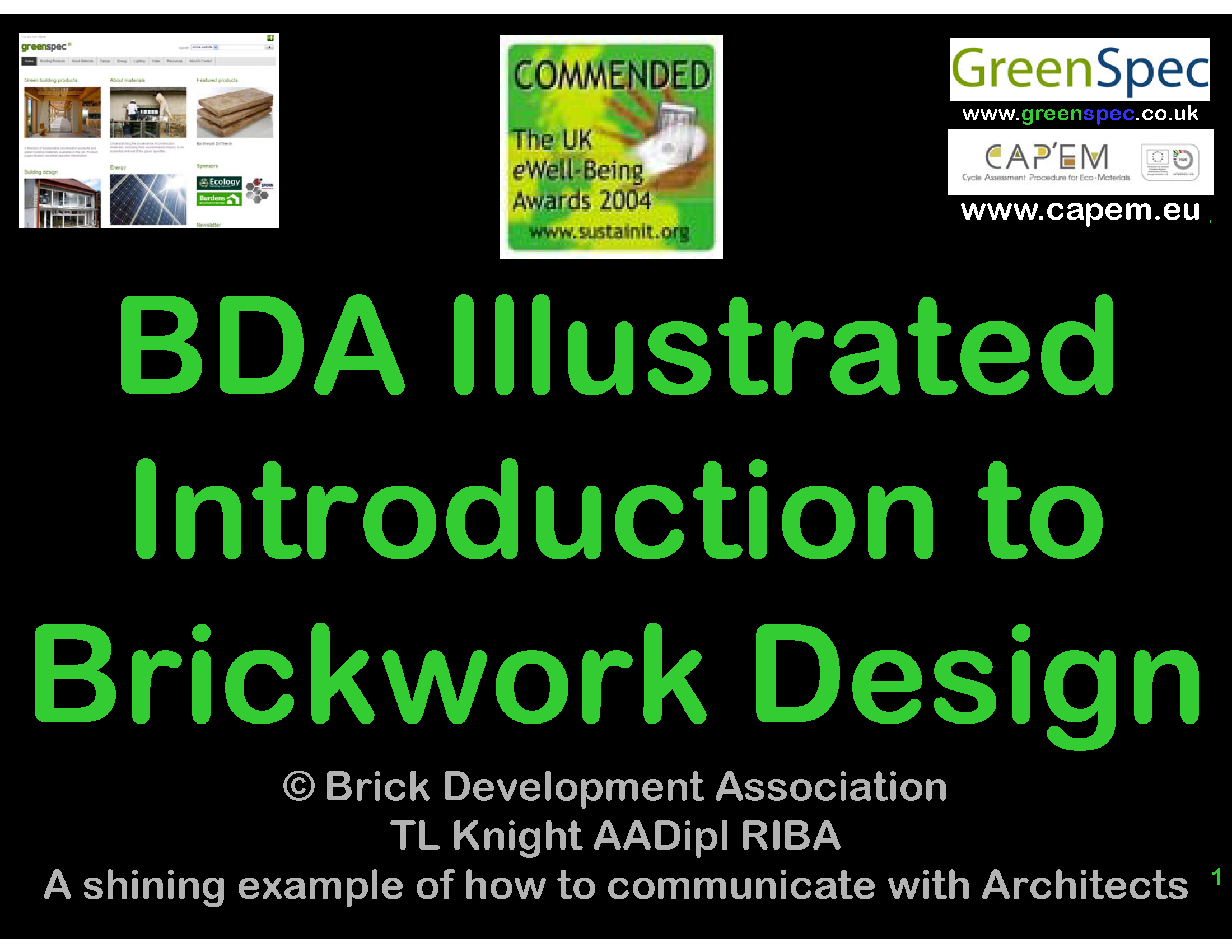
F10 Brick/Block Walling Checklist
Index:
Problems:
- Fired clay brick manufacture consumes high levels of energy
- Primary or Virgin aggregates used in concrete blockwork
- Ordinary Portland Cement (OPC) manufacture consumes high levels of energy and generates high levels of Carbon Dioxide (CO2)
- OPC is used in concrete blockwork
- Autoclaved Aerated Concrete (AAC) blocks consume high levels or energy, water and CO2 generating OPC
- No fined concrete blocks make air permeable blockwork walls
- Extruded cellular fired clay blocks have dry interlocking perpends and make air permeable walls
- Parge coats need to be continuous with surrounding elements to avoid being air leaky at floors and roofs
- Buried conduits are potential routes for air leakage since junction boxes are rarely airtight
Bad Habits:
- Topping and tailing perpend mortar in brickwork and blockwork modifies the performance of the walls: strength and stability, fire, conduction thermal, radiant thermal, acoustic performances, airtightness, moisture permeability; and should be avoided
- Mixing bricks and blocks in a wall to accommodate unco-ordinated lintels and pad stones and at heads of walls under slabs or between joists supported in walls: modifies the performance (see above) of the wall local to thermal bridging components to enlarge the thermal bridge area; and should be avoided.
Solutions:
- Extruded clay cellular blocks and bricks use less energy to ‘cook’
- Primary or Virgin Aggregate replacement with Recycled, Secondary or manufactured Aggregates (in blocks and mortar)
- Manufacturers are now using many aggregate substitutes: Paper, wood particles, pumice (lightweight), plastics,
- Lime in preference to OPC in aggregate concrete blocks
- Blended GGBS and OPC in aggregate concrete blocks
- Lime mortar in preference to OPC mortar in brickwork or blockwork
- Ground Granulated Blast Furnace (GGBS) Cement in preference to OPC mortar (If height and speed not an issue)
- Blended GGBS and OPC mortar in preference to OPC mortar (If height and speed are an issue)
- Parge coats of clay or lime plaster make air permeable walls airtight and moisture permeable (Vapour open)
- Parge coats of gypsum plaster or cement render make walls air and moisture tight (Vapour closed)
- Brick and block offer decrement delay characteristics reducing radiant solar heat gains through external walls
- Brick and dense block offer useful thermal mass if at wall surfaces to absorb radiant solar gains through windows
Misunderstandings:
- Stronger is not always best:
- uses more high energy consuming and high CO2 generating materials than necessary
- stronger mortar in facing brickwork or blockwork puts the brick or block at risk of frost damage
- stronger mortar prevents reclaiming of bricks and blocks
Use:
- Lime mortar in preference to OPC mortar. See Z21
- Blended GGBS and OPC cement mortar in preference to OPC mortar, See Z21
- Cement made from other than limestone
Consider:
- Surface mount conduits or run wiring in surface mounted hollow skirting/dado
- Perforated and better still extruded cellular bricks and blocks:
- Less material consumed
- Less energy to ‘cook’
- Lightweight to transport and handle
- Lighter and less wear and tear on labourers
- Handgrips moulded into block ends
- Make door openings brick or block multiple widths and heights
- Co-ordinate window and door opening with brick sizes and blocks modules
- Co-ordinate lintels and pad-stones to brick sizes or block modules. See F31
- Start full course of bricks and blocks on floors
Bricks
- In the UK we use to make 3 billion clay bricks each year
- Use unfired clay bricks or blocks for walls, (low energy use in production)
Blocks
- Use non-porous blocks to make airtight walls
- Use blocks with high percentage of recycled, secondary or manufactured aggregate
- Use double skins to make up thick walls observing UK 20 kg maximum for one man lifting
- There are cement-concrete block manufacturers that use GGBS and/or PFA cement substitution
- There are cement-concrete block manufacturers that use secondary aggregates substitution for virgin or primary aggregates: recycled glass, china clay, slate and others
- Use GGBC cement not OPC for recycled glass aggregate blocks
- OPC replacement by GGBS or PFA cements
- Lime based mortar and reclaim of blocks for reuse, which requires tough blocks
- Plastics as aggregates for limiting crack propagation and improved tension strength
- Pumice lightweight insulating aggregate blocks (Greek/French product)
- Thermal Mass is really only useful if at the surface and exploited
- Thermal mass and fairfaced dense block go together
- Thermal mass and thermal insulating at the same time would be interesting to have but unlikely bedfellow
Resource efficiency and waste minimisation by manufacture and by design
- Cut blocks to size to minimise on site cutting
- Design guidance on block size tables and work around openings and lintels and at abutments to minimise cutting waste
Avoid:
- Use of cement mortar and cement concrete blockwork: cement production generates high levels of CO2
- See E10
- Chasing brickwork and blockwork to run buried conduits, a very dirty job making the building a no-go area whilst in progress
- Filling conduit chases using cement based render
- Cutting bricks and blocks: design walls and openings to co-ordinate with unit sizes
Minimise:
- Use of OPC mortar
- Cutting of blocks
Substitute:
- Limecrete blocks (none as far as we know)
- Hemp-lime blocks (UK/French)
- Timber-lime blocks (Eastern Europe)
- Cellular fired clay blocks (EU and UK)
- Papercrete blocks (UK soon)
Health:
- OPC and lime is alkali and bad for skin and eyes
- OPC is very fine avoid breathing into lungs
- Wear protective clothing and gloves
Wellbeing:
- Some people like the solidity of brick houses
- Some people do not like hollow partitions
Biodiversity:
- Crushed fletton commons make good aggregates for brown roofs
Safety:
- Bricks, blocks and mortar are all heavy
Precautionary principle:
Resource Efficiency Issues:
- Design For Demountability:
- Thick blockwork walls used with external insulated render could be laid in lime mortar to encourage the possibility to reuse them at the end of the buildings life
- Site walls made of solid brickwork could be laid in lime mortar to encourage reuse of bricks
Reduce:
Reclaim:
- Reclaimed Bricks originally laid in lime mortar
- London Stocks are worth at least a £1.00 each
- If your site has no use for them Architectural Salvage years will take them
Reuse:
- Architectural Salvage Gateway: Salvo
- Remember reclaimed brick may be imperial or metric dimensions
- Reuse bricks local to the source to avoid transport impacts cancelling the advantage of reuse
Recycle:
- Cement mortared brick and blockwork, crushed as hardcore or piling mat
- Fletton common brick rubble as brown roof aggregates
- Some block manufacturers use 85% recycled aggregates
- Some recycled aggregate blocks manufacturers will only sell locally to the source of the aggregate
Recover:
- Wood particle aggregate would be difficult to burn out of the block when coated by cement
Waste Issues:
- Cement mortar once gone off is likely to be inert
- Lime mortar is not inert until completely hydrated which can take a long time if bulky
- Fired clay bricks are inert
- Concrete blocks are inert
- Wood aggregate lime matrix blocks are potentially mixed active and inert
Hazardous waste & Deleterious Substances
- Lime mortar is potentially hazardous until gone off and then inert, but landfill heat could reactivate its capacity to react with water and rehydrate
Waste statistics
- 30 m tonnes (33% of 90 m. tonnes/year) of waste is offcuts (not all masonry)
- In the UK we throw away 2 billion bricks each year and make another 3 billion
Waste minimization
- Plan layouts, wall lengths and openings to acknowledge the size of bricks and blocks with minimum offcut waste
End of Life options
- Use lime mortar to enable reclamation of bricks and blocks
Appropriateness:
Competence:
Effectiveness:
Yardstick:
Maintenance issue:
- Bricks and block are both low maintenance materials
Industry/Sector Initiatives:
Information sources:
- BDA
- Brick Development Agency (BDA)
© GBE NGS ASWS BrianMurphy
aka BrianSpecMan
2001 – 19th September 2014 – 22nd August 2016
F10 Brick/Block Walling Checklist
Images:
Fig. 1 Book BDA Illustrated Guide to Brickwork Design


© GBE NGS ASWS BrianMurphy
aka BrianSpecMan
19th September 2014 – 22nd August 2016
F10 Brick/Block Walling Checklist
See Also:
GBE JARGON BUSTER
- Term
- Z21
- Mortar (Z21)
GBE CPD
- Brick Development Association Publication
- Book BDA Illustrated Guide to Brickwork Design (PDF) N#238
GBE Shop
GBE Checklist
Classification
- F31
- Z21
Trade
- Accessories (F31)
- Mortar (Z21)
GBE Links
- Organisation/Website
- BDA
GBE Manufacturers
- Econovate Ltd. G#1800 N#1687
GBE Products
Papercrete Bloc
GBE MATERIALS
GBE SYSTEMS
GBE ELEMENTAL ASSEMBLIES
GBE FABRICATORS
GBE SUPPLIERS
GBE CALCULATOR
- Bat Roost and Bird Box coordination sizes for masonry and timber frame
- WasteCost® Lite waste calculator
GBE CAD
GBE GREEN BUILDING SPECIFICATION (GBS)
- F10 BRICK/BLOCK WALLING
GBE PROJECTS
© GBE NGS ASWS BrianMurphy
aka BrianSpecMan
19th September 2014 – 22nd August 2016


